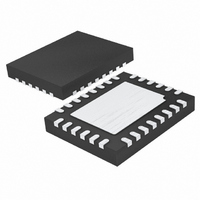LTC3850EUF#PBF Linear Technology, LTC3850EUF#PBF Datasheet - Page 17

LTC3850EUF#PBF
Manufacturer Part Number
LTC3850EUF#PBF
Description
IC CNTRLR STP DWN SYNC 28-QFN
Manufacturer
Linear Technology
Series
PolyPhase®r
Type
Step-Down (Buck)r
Datasheet
1.LTC3850EUFPBF.pdf
(38 pages)
Specifications of LTC3850EUF#PBF
Internal Switch(s)
No
Synchronous Rectifier
Yes
Number Of Outputs
2
Voltage - Output
0.8 ~ 23.3 V
Current - Output
100mA
Frequency - Switching
250kHz ~ 780kHz
Voltage - Input
4 ~ 24 V
Operating Temperature
-40°C ~ 85°C
Mounting Type
Surface Mount
Package / Case
28-QFN
Primary Input Voltage
24V
No. Of Outputs
2
Output Current
100mA
No. Of Pins
28
Operating Temperature Range
-40°C To +85°C
Msl
MSL 1 - Unlimited
Supply Voltage Range
4V To 24V
Rohs Compliant
Yes
Lead Free Status / RoHS Status
Lead free / RoHS Compliant
Power - Output
-
Available stocks
Company
Part Number
Manufacturer
Quantity
Price
APPLICATIONS INFORMATION
voltage and maximum output current. Miller capacitance,
C
usually provided on the MOSFET manufacturers’ data
sheet. C
along the horizontal axis while the curve is approximately
flat divided by the specified change in V
then multiplied by the ratio of the application applied V
to the gate charge curve specified V
operating in continuous mode the duty cycles for the top
and bottom MOSFETs are given by:
The MOSFET power dissipations at maximum output cur-
rent are given by:
where d is the temperature dependency of R
R
at the MOSFET’s Miller threshold voltage. V
typical MOSFET minimum threshold voltage.
Both MOSFETs have I
equation includes an additional term for transition losses,
which are highest at high input voltages. For V
the high current efficiency generally improves with larger
MOSFETs, while for V
increase to the point that the use of a higher R
with lower C
synchronous MOSFET losses are greatest at high input
voltage when the top switch duty factor is low or during
MILLER
DR
Main Switch Duty Cycle =
Synchronous Switch Duty Cycle =
P
P
SYNC
MAIN
(approximately 2Ω) is the effective driver resistance
, can be approximated from the gate charge curve
MILLER
=
=
( )
V
V
V
V
MILLER
IN
V
INTVCC
IN
OUT
IN
2
– V
V
is equal to the increase in gate charge
IN
(
I
I
OUT
MAX
actually provides higher efficiency. The
MAX
– V
2
2
1
IN
R losses while the topside N-channel
(
)
TH(MIN)
> 20V the transition losses rapidly
I
2
MAX
(
(
R
1+ δ
DR
)
V
2
V
)
OUT
(
)
+
IN
(
1+ δ
R
C
V
DS(ON)
MILLER
TH(MIN)
)
1
DS
R
V
IN
DS(ON)
. When the IC is
DS
+
)
– V
V
•
. This result is
IN
TH(MIN)
DS(ON)
• f
OUT
OSC
DS(ON)
IN
device
< 20V
is the
and
DS
a short-circuit when the synchronous switch is on close
to 100% of the period.
The term (1 + d) is generally given for a MOSFET in the
form of a normalized R
d = 0.005/°C can be used as an approximation for low
voltage MOSFETs.
The optional Schottky diodes conduct during the dead
time between the conduction of the two power MOSFETs.
These prevent the body diodes of the bottom MOSFETs
from turning on, storing charge during the dead time and
requiring a reverse recovery period that could cost as much
as 3% in efficiency at high V
generally a good compromise for both regions of opera-
tion due to the relatively small average current. Larger
diodes result in additional transition losses due to their
larger junction capacitance.
Soft-Start and Tracking
The LTC3850 has the ability to either soft-start by itself
with a capacitor or track the output of another channel or
external supply. When one particular channel is configured
to soft-start by itself, a capacitor should be connected to
its TK/SS pin. This channel is in the shutdown state if its
RUN pin voltage is below 1.2V. Its TK/SS pin is actively
pulled to ground in this shutdown state.
Once the RUN pin voltage is above 1.2V, the channel pow-
ers up. A soft-start current of 1.3µA then starts to charge
its soft-start capacitor. Note that soft-start or tracking is
achieved not by limiting the maximum output current of
the controller but by controlling the output ramp voltage
according to the ramp rate on the TK/SS pin. Current
foldback is disabled during this phase to ensure smooth
soft-start or tracking. The soft-start or tracking range is
defined to be the voltage range from 0V to 0.8V on the TK/
SS pin. The total soft-start time can be calculated as:
Regardless of the mode selected by the MODE/PLLIN pin,
the regulator will always start in pulse-skipping mode up
to TK/SS = 0.64V. Between TK/SS = 0.64V and 0.74V, it
will operate in forced continuous mode and revert to the
t
SOFTSTART
= 0.8 •
LTC3850/LTC3850-1
1.3µA
C
DS(ON)
SS
IN
vs Temperature curve, but
. A 1A to 3A Schottky is
17
38501fc













